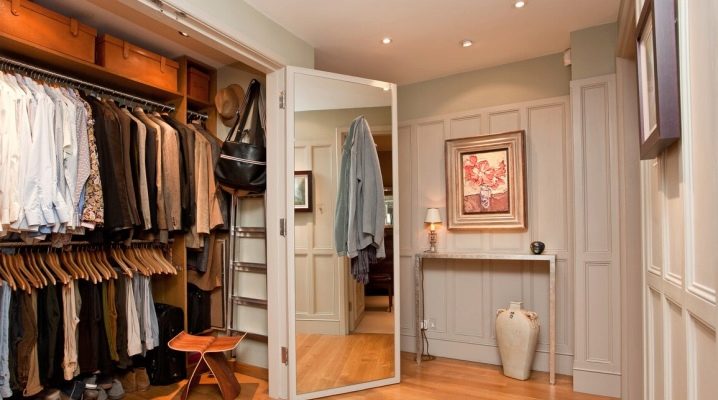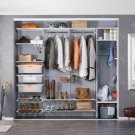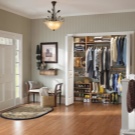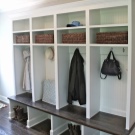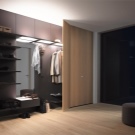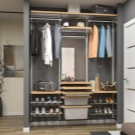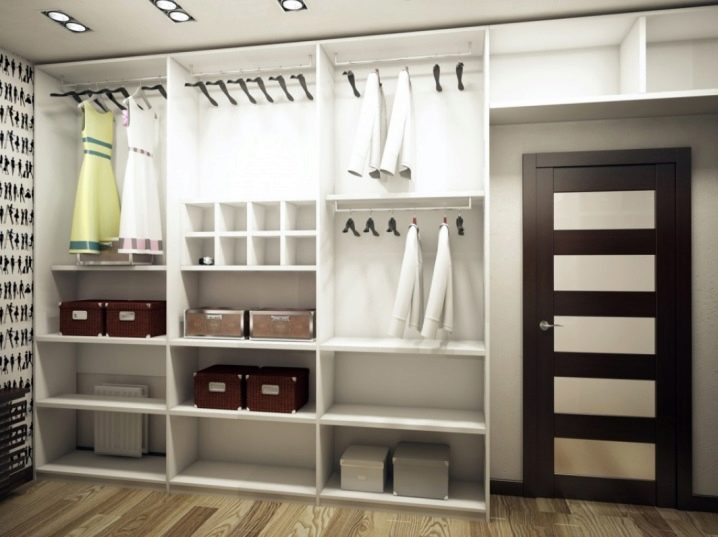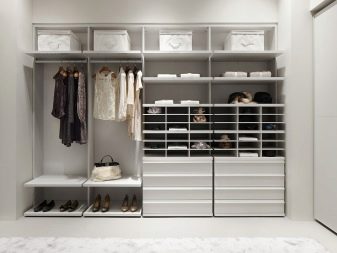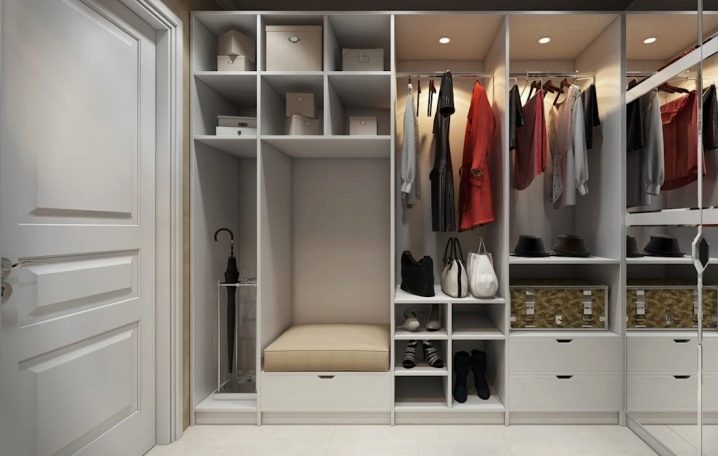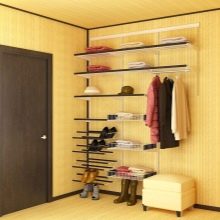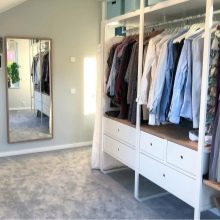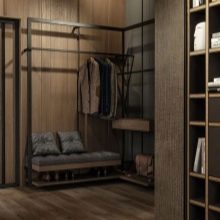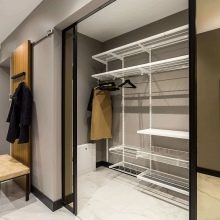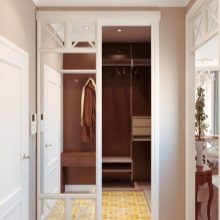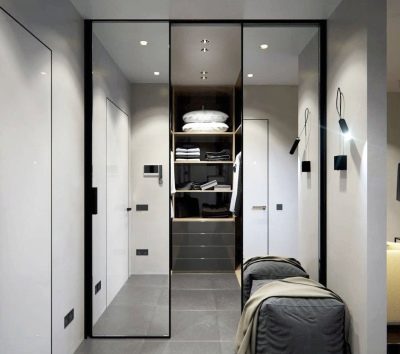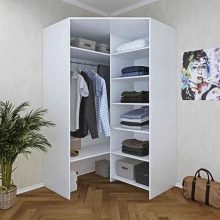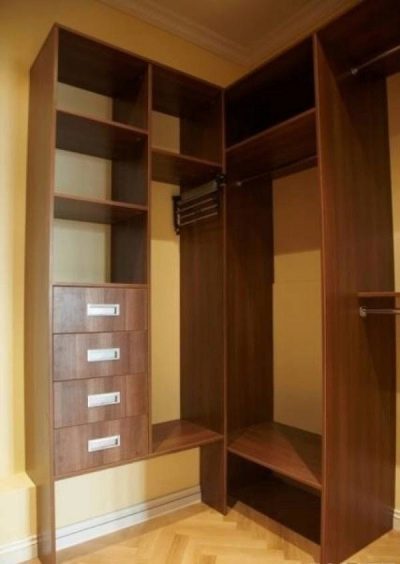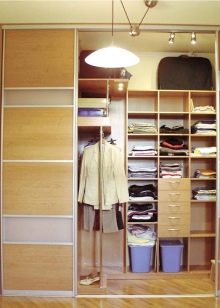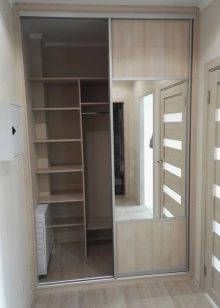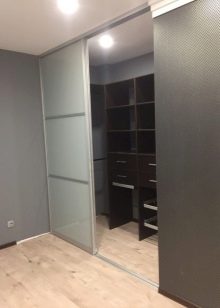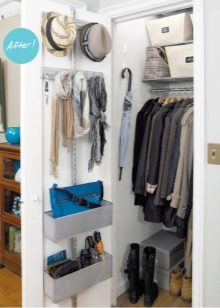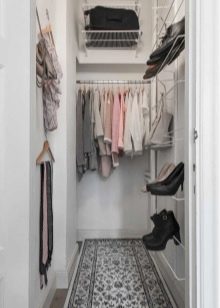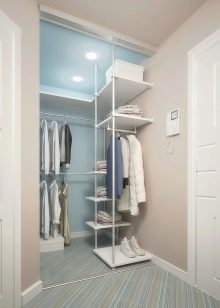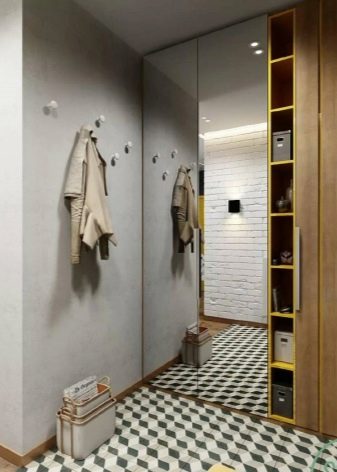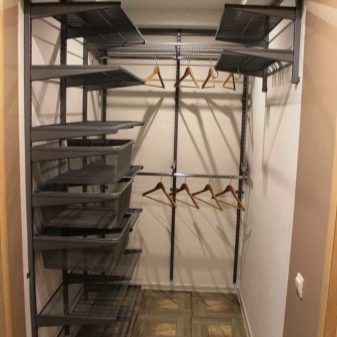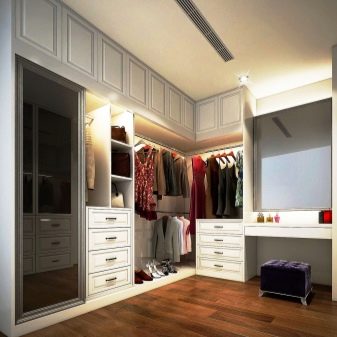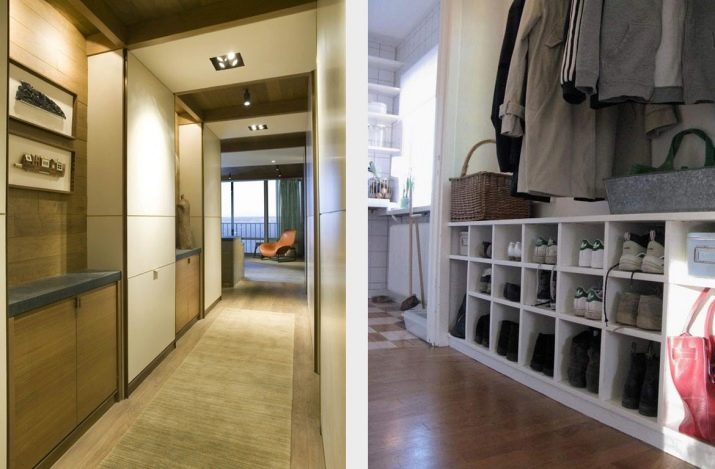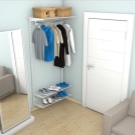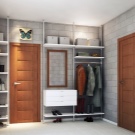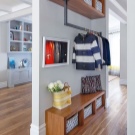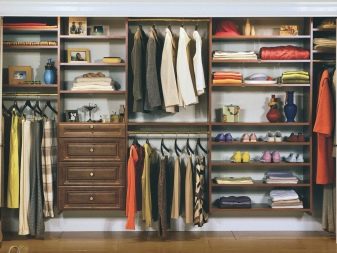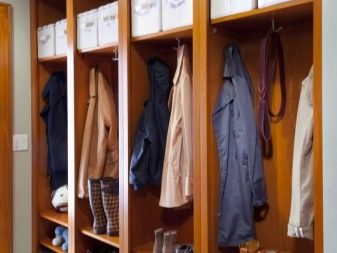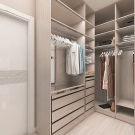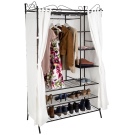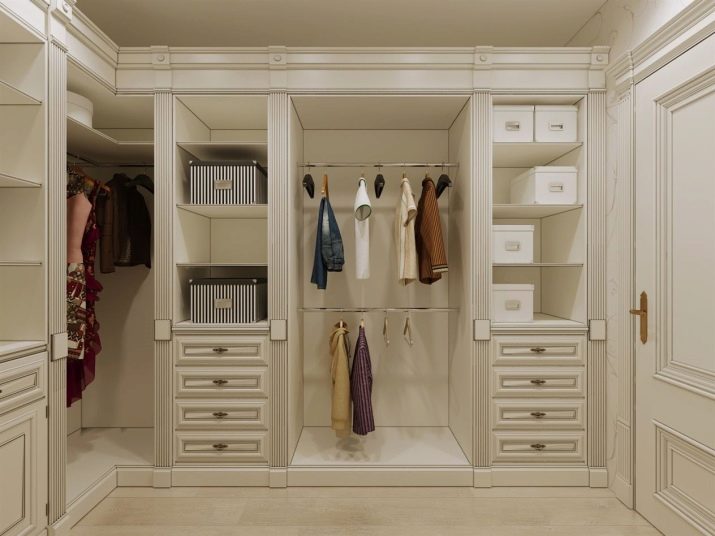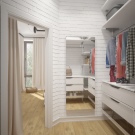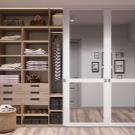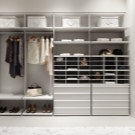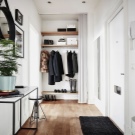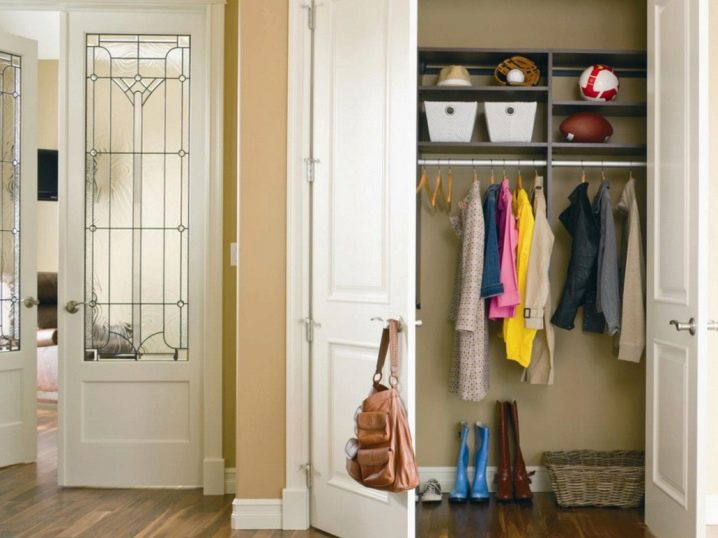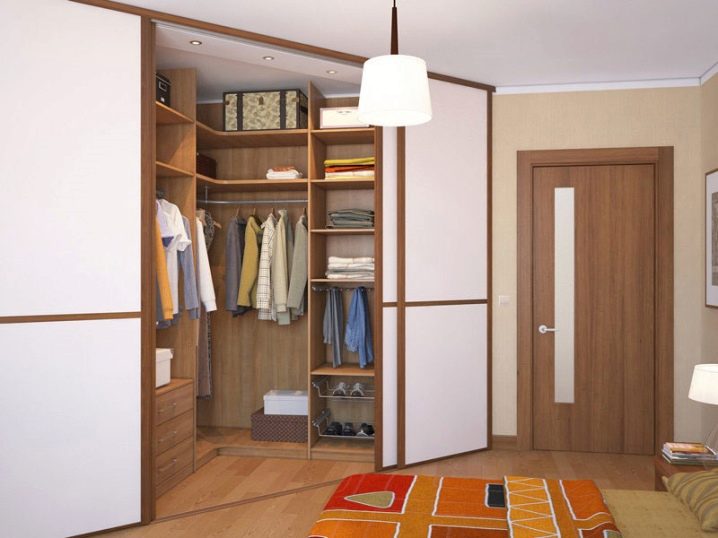Organization of a dressing room in the hallway
In order not to force all rooms with different-sized wardrobes and not create problems for yourself with organizing storage, it is most reasonable to equip a full-fledged dressing room in the hallway. By making a custom-made design, you will be able to get the best option for a particular apartment.
Advantages and disadvantages
The dressing room in the hallway has both a number of advantages and some disadvantages. The main advantage of this design is its convenience: if you organize everything wisely, then you can generally get rid of bulky wardrobes in the bedroom, nursery, corridor, living room and other rooms. All things will be stored in one place, each will have its own place, and the correct distribution of internal space will permanently eliminate the problem of disorder and loss of things. An aesthetic wardrobe will decorate the hallway, and also allow you to mask irregularities and damage to walls, unnecessary columns, niches and other architectural solutions... Moreover, by placing a large mirror on the front door of the structure, it will be possible to visually expand the room.
Typically, a custom-made dressing room can even fit into a small space. The design allows you to use every free meter wisely, as well as to choose shelves, hangers and storage systems for specific things. Also, depending on the material used, it turns out to choose an option for any wallet.
As for the shortcomings, the main one can be called complex installation, which in most cases is subject only to persons with the appropriate skills.
If a built-in dressing room is arranged in the apartment, then it will be impossible to transfer it, because the model is adjusted exactly according to the available dimensions and in accordance with the curvature of the walls.
Finally, such built-in structures spoil the state of the surfaces at the expense of the need use self-tapping screws, dowels and other fastening accessories.
Species overview
In a private house or in an ordinary city apartment, you can install various options for dressing rooms.
Open
An open dressing room consists of several vertical partitions made of wood, metal, plastic or drywall, complemented by shelves, rails, baskets, drawers and hangers. Some experts believe that in this kind of model, closed boxes are permissible only in the lower part of the structure. This storage system takes up minimal space, and also visually "lightens" and expands the corridor, but requires constant maintenance of order. It is best installed in small spaces. Another plus is the ability to swap shelves and rails.
In order to minimize clutter in an open dressing room, it is customary to use for storage decorative boxes, baskets and containers of various sizes. Near the section where outerwear and shoes will be stored, a pouf or a small bench is usually installed.
Closed
A closed wardrobe is most conveniently placed in a niche, although, in fact, this piece of furniture can occupy a hallway of any configuration. Its dimensions depend only on the size of the apartment and the needs of its owners. This type of wardrobe makes it possible to hide things from prying eyes and prevent dust from getting inside. The design is always hidden behind doors decorated with voluminous details, unusual fittings or mirrors.If the size of the hallway allows, then inside you can even organize a small boudoir, putting a dressing table inside, mounting a mirror and placing a hairdryer. In addition, a large dressing room will certainly require the organization of a lighting system.
Basically, any closed dressing room looks like a large wardrobe. with hinged, sliding or folding doors... Inside, only shelves can be located or their combination with drawers, slats, baskets and other details.
Corner
It is customary to understand corner wardrobes as trapezoidal, triangular or radial modular structures, and their shape does not have to be geometrically correct - concave, convex, and wavy bends are allowed. Inside the wardrobe there are also corner shelves, various drawers and crossbars. Since the corner structure can look quite cumbersome, it is customary to make it either completely open or partially. Mirrors on the doors also visually increase the space.
By the way, corner wardrobes are indispensable in "Khrushchev" and "Stalin" buildings, whose small hallways do not allow much to turn around.
Built-in
A built-in dressing room is usually placed in an existing storage room or a deep niche in the apartment, which allows you to save free square meters to the maximum. It is also recommended to install such a structure in a corridor with a non-standard architectural form. Such a wardrobe does not require a frame, and therefore it comes out cheaper than, for example, a closed one. The structure is solid, but not movable from the place, since its walls are the walls of the apartment itself.
Planning
To properly plan a dressing room, it is necessary to focus on the size and configuration of the space in which it will be accommodated. So, if the plan shows that the entrance area is a geometrically correct spacious room, it makes sense to separate the wardrobe due to a fake plasterboard wall with an entrance inside. For a narrow and elongated corridor, as a rule, projects of a closed wardrobe or a built-in structure mounted along one wall are implemented. By the way, any non-standard layout, especially with beveled corners, ledges or beams, requires a built-in wardrobe, made to order according to a specific apartment layout. For a small apartment, especially a "Khrushchev" apartment, an open mini-wardrobe with an area of about 1-2 square meters is suitable. m.
Even in a small one-room apartment "new building", the area of the hallway usually allows you to organize a fairly spacious closed-type dressing room, starting near the entrance and going along the wall. A corner structure will also fit well in a square space. VIn general, for an apartment of standard sizes, the wardrobe area of 4-5 square meters is considered optimal. It is more logical to place a miniature structure against the wall with the largest area, and to use compartment-type doors to save space.
It is recommended to equip a large dressing room with several bars at different levels and a sufficient number of drawers and shelves. Shoes are usually placed in a so-called pencil case - a narrow and high compartment.
In general, when planning a wardrobe, it is important to take into account that at least four zones are located in it: for outerwear, for shorter items, a shoe rack and drawers for linen and similar things. A plus will be the presence of a dressing area. The optimal depth for shelves is 30-40 centimeters, and for sections with a barbell - 60 centimeters. Woven or mesh organizers with pockets are suitable for small items. The simplest open-type wardrobe is formed from several shelves and rails.
Filling
The internal content, of course, should depend on the needs of the inhabitants of the apartment, but it is easier to organize it according to an established scheme. So, on the upper tier, hats, warm blankets, seasonal accessories and rarely used items should be located; in the middle section - outerwear and other clothes, and at the bottom it is better to arrange a segment for shoes and household accessories. A large number of shoes can also be stored in boxes, for which a separate case is allocated. Inside the dressing room there should be a sufficient number of rods, drawers, hooks, shelves, baskets, organizers, retractable hangers for skirts and trousers, as well as special sections.
If space permits, then here it is worth mounting an ironing board, a device for fixing an iron, trembles for belts and other accessories.
Design
There are a huge number of ideas on how to arrange a dressing room, but they should all be thought out taking into account the interior of the apartment. From the inside, the space, as a rule, is simply painted over or decorated with wall panels. The doors of the structure can be made of natural wood or laminated MDF, as well as ordinary plastic. Often, facades are decorated with mirrors, bamboo or rattan inserts, stained-glass windows, frescoes, paintings or glass. The design can be supplemented with a photo image that matches the design idea of the hallway. The composition of a metal frame and blackout curtains looks quite original.
For example, to decorate a space in a classic style, hinged doors decorated with patina and gilding are usually used, as well as special nets that create an aging effect. Expensive wood, carved details, gilded fittings and pilasters also contribute to the creation of the interior. When creating a Scandinavian-style dressing room, preference should be given to white painted wood and an open storage system to the maximum.
Examples in the interior
In a small space, it is most appropriate to place an open-type dressing room, formed from several shelves, a bar and pull-out mesh drawers. The white color of the structure does not overload the space and looks great against the background of beige walls. Its shade "echoes" the shade of the baseboards and door frames. A small structure is intended for "weekend" things, that is, outerwear, shoes, bags, hats and accessories of all family members are able to sit on it.
In a more spacious hallway, if there is a niche, all of the above can be hidden in a closed or built-in dressing room. A long bar and a row of shelves are hidden behind the white hinged doors that continue the overall design of the interior. There is enough space at the bottom to store shoes or to accommodate additional storage systems.
A large corridor also makes it possible to place a large built-in corner wardrobe. If you open the compartment doors, then inside you will find space, which is enough not only for storing things, but also for changing clothes. The internal filling is organized in such a way that there are shelves, drawers, several bars, and special shoe racks.
